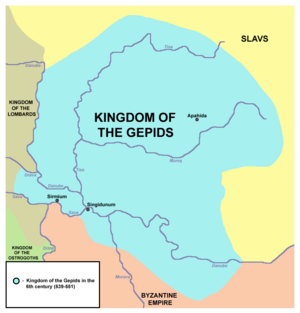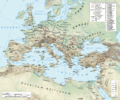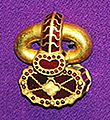Gepids facts for kids
The Gepids were an ancient Germanic tribe. They were related to the Goths. The Gepids became very well-known after they defeated the powerful Huns. The land where the Gepids lived was called Gepidia. It was also known as the Kingdom of the Gepids. This area today includes parts of countries like Romania, Hungary, and Serbia.
Contents
Who Were the Gepids?
The Gepids were a group of people from a larger family of tribes called the East Germanic peoples. They were similar to the Goths, another famous Germanic tribe. These tribes moved around a lot in ancient times. The Gepids eventually settled in a region of Central Europe.
Early History and Migrations
Historians believe the Gepids originally came from areas near the Baltic Sea. They slowly moved south over many years. Like many other tribes, they were looking for new lands to live in. Their journey eventually brought them to the Carpathian Basin. This area is a large plain surrounded by mountains.
Life in Gepidia
The Kingdom of the Gepids was a significant power in its time. It was located in a fertile region. This allowed the Gepids to farm and raise animals. They also controlled important trade routes. This helped their kingdom become wealthy.
Culture and Daily Life
The Gepids were skilled warriors. They were also good at crafting. Archaeologists have found many beautiful items from their time. These include jewelry, weapons, and tools. Their art often featured animal designs. They lived in villages and had a structured society.
The Gepids and the Huns
One of the most famous moments in Gepid history was their victory over the Huns. The Huns were a fearsome group of warriors from Asia. They had built a huge empire in Europe. The Huns were led by their famous leader, Attila.
The Battle of Nedao
After Attila the Hun died in 453 CE, his empire began to weaken. The Gepids, led by their king Ardaric, saw an opportunity. They joined forces with other Germanic tribes. In 454 CE, they fought a major battle against the Huns. This battle is known as the Battle of Nedao.
A Major Victory
The Gepids and their allies won a great victory at Nedao. This battle was a turning point in history. It broke the power of the Huns in Europe. The Gepids then became one of the most powerful tribes in the region. They established their own strong kingdom.
The Kingdom of the Gepids
After defeating the Huns, the Gepids established their own kingdom. It was centered in the area of modern-day Transylvania and the Pannonian Plain. Their capital city was Sirmium. This city was an important center for trade and politics.
Relations with the Roman Empire
The Gepids had a complex relationship with the Eastern Roman Empire. Sometimes they were allies. Other times, they were enemies. The Romans often paid the Gepids to keep the peace. They also hired Gepid warriors to fight in their armies.
Trade and Influence
The Gepid kingdom was located at a crossroads of different cultures. This allowed them to trade with many groups. They traded goods like furs, amber, and metals. Their kingdom became a hub for cultural exchange. This helped them gain wealth and influence.
The End of the Gepid Kingdom
The Gepid kingdom lasted for over a century. However, they faced new threats over time. Other powerful tribes began to emerge. The Gepids often fought with their neighbors, especially the Lombards.
Wars with the Lombards
The Lombards were another Germanic tribe. They moved into the Pannonian Plain. This led to many conflicts with the Gepids. The Lombards eventually formed an alliance with the Avars. The Avars were a new group of powerful warriors from Asia.
The Fall of Gepidia
In 567 CE, the Lombards and Avars launched a major attack. They defeated the Gepids in a decisive battle. This marked the end of the Gepid Kingdom. Many Gepids were killed or absorbed into other groups. Some joined the Lombards. Others became part of the Avar Empire.
Legacy of the Gepids
Even though their kingdom fell, the Gepids left their mark on history. They played a key role in the fall of the Huns. They also helped shape the early medieval period in Central Europe. Their story reminds us of the many different groups who lived in ancient times.
Images for kids
-
Coin of the Gepids c. 491–518. Sirmium mint. In the name of Byzantine Emperor Anastasius I.
-
Coin of the Gepids. Sirmium mint. Struck in the name of Justin I, c. 518-526 CE. Obv: D N IVSTINVS P LV (first N retrograde), pearl-diademed and cuirassed bust right. Rev: VINVICTL ROMLNI, large “Theodericus” monogram across fields, cross above.
See also
 In Spanish: Gépidos para niños
In Spanish: Gépidos para niños







